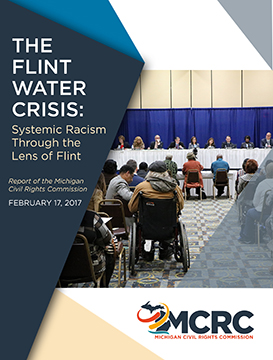By Patsy Isenberg
The underlying issue in the Flint water crisis was “the role of race,” Agustin Arbulu, director of the Michigan Department of Civil Rights, asserted in a Tendaji Talk at the Flint Public Library Dec. 12.

Agustin Arbulu at the Flint Public Library (photo by Patsy Isenberg)
In summarizing the work of the Michigan Civil Rights Commission culminating in a report on the water crisis released in February, Arbulu said, “That’s what civil rights is about: how do certain communities end up at a disadvantaged position? How do they end up being marginalized? How does the system reproduce themselves so that it creates this gap, this separation of race, wealth and opportunity?”
Those concerns “came up continuously as we held hearings and we began to think about what was going to be the perspective that the commission was going to take,” Arbulu said.
The difference between how the crisis would have been handled in a wealthier community versus how it was handled here in Flint is clear, Arbulu said. “Race of course played a role. And that in wealthier communities it would have been addressed… not in Flint. We all know.” Flint, he said, is a community at a disadvantage.
The Tendaji Talks, honoring the life and social justice work of the late Tendaji Ganges, are a series organized by Neighborhood Without Borders (NWB), described on its Facebook page as “a grassroots effort that seeks to break down racial, cultural, religious and economic barriers to undo racism in Flint.” Fourteen attended this month’s talk.
The MCRC report, in conjunction with findings from three hearings held to investigate the water crisis, made the following seven recommendations:
- Listening to the concerns of residents.
- Understanding radicalization and bias.
- Providing environmental justice.
- Amending the emergency manager law.
- Acknowledging racial equity.
- Rebuilding trust and credibility
- Obtaining regional cooperation.
 The full Civil Rights Commission report can be found here. The recommendations were explored in detail by EVM Editor Jan Worth-Nelson in her story following the release of the report, available here.
The full Civil Rights Commission report can be found here. The recommendations were explored in detail by EVM Editor Jan Worth-Nelson in her story following the release of the report, available here.
Arbulu showed the group a map of Michigan indicating where the concentrations of African American and white populations. The map clearly showed the concentration of African Americans primarily in urban areas — Flint in particular since that is where the water crisis occurred– but also Detroit, Pontiac and others.
The map indicates that “Michigan continues to be a fairly segregated society and this doesn’t just happen and this doesn’t just come about. It is years and years in the making. And that is something that has been part of the long history of the Civil Rights Commission, in fighting discrimination,” Arbulu said.
Early in the crisis, he recounted, the commission voted unanimously to hold three hearings to determine whether people’s civil rights were abridged during the crisis. He pointed out that despite media attention on the crisis, there were groups of people in Flint that were unaware the crisis was even going on: Hispanics who didn’t speak English or were undocumented, disabled people who might be blind or hearing impaired, and many seniors who didn’t know to reach out for help or couldn’t. He pointed out that the MDCR worked to support those groups through the crisis as well.
Arbulu then explained how segregation in Michigan came about historically. Arbulu took the attendees through the various events going back to the 1920s and 30s which fed into what happened in the water crisis. He noted industrialization in Flint, The Great Depression, the rise and fall of the auto industry, WWII (which offered GI loans for mostly white military who came back from the war and bought real estate), and the boom that occurred at that time. All these factors played a part, he said, compounded more recently negative effects by the 2008 recession and unemployment.
According to Arbulu, fighting racism, unlike the remedial problems with the water crisis such as pipe replacement and getting filters and bottled water to the citizens which happened relatively fast, will take much longer to improve.
Arbulu then offered tips on how to tackle racism. He mentioned a test available on the internet to determine a person’s “implicit bias,” in which people are unaware of their racism.
“We all have it,” Arbulu said, adding it takes a real effort to change. The test can be found here.
Touching on the sixth recommendation of rebuilding trust and credibility, Arbulu described a program launched in 2016 by the W.K. Kellogg Foundation (WKKF) called “Truth, Racial Healing & Transformation” (TRHT) which is working toward implementing this recommendation.
According to its website, TRHT is a “community-based process to plan for and bring about transformational and sustainable change, and to address the historic and contemporary effects of racism.” The program is run in 14 places across the country, including four in Michigan: Battle Creek, Flint, Kalamazoo, and Lansing.
The goal of the TRHT, according to the site, is to study and listen to people in the 14 communities in areas such as changing community narratives, examining ways to address segregation and economic inequality, considering ways to heal from wounds from the past, and reviewing discriminatory civil and criminal laws and policies.
More information about TRHT and how to get involved is available here.
EVM staff writer Patsy Isenberg can be reached at pisenberg@gmail.com.


You must be logged in to post a comment.